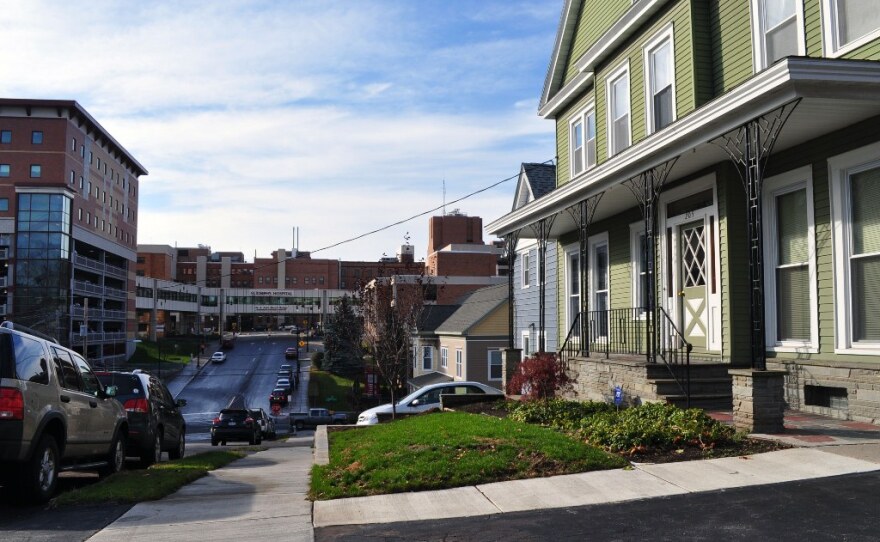Construction cranes poke above the already looming structure of St. Joseph's Hospital on the north side of Syracuse. Women in hospital scrubs and men in reflective vests and hard hats walk past, but Dominic Robinson is facing the other direction.
Robinson is the founder of a community organization called the Northside Urban Partnership, or Northside UP. He chose to meet at this spot to point out the buildings across the street from the hospital, the Prospect Hill Homes.
"These are townhome units that have replaced some of the most dilapidated, blighted housing on the north side and maybe all of Syracuse," Robinson explains.
Before the new affordable housing units were built, it was not uncommon for hospital employees to witness seedy activity leaving the hospital after a late night shift. "That doesn't exist really on these blocks anymore," he says.
Now many hospital workers enjoy the short commute living in the neighborhood provides.
Economic impact
Money from St. Joseph's Hospital helped fund the construction of the new homes. The hospital also helps support Robinson's Northside UP initiative.
Health%20care%20generates%20%24107.9%20billion%20annually%20in%20economic%20activity%20in%20New%20York
The 140 year-old Catholic hospital estimates its annual economic impact on Syracuse to be $863 million. That's just a chunk of the $3.1 billion the Healthcare Association of New York State, an advocacy group, estimates health care pumps into central New York every year. The health care industry also supports 23,270 jobs in the region.
That money comes from worker salaries, indirect job creation - like construction jobs, and buying supplies and services from area vendors.
Those numbers don't include the community investments St. Joseph's had made in the past few years. The hospital's president, Kathy Ruscitto, says the motivation comes from the philosophy of the nuns who started the hospital.
Since undertaking a $220 million expansion of the hospital, Ruscitto says St. Joe's has tried to be more involved.
"Now we’re trying to use that [economic influence] in a little more directed way," she says. "To say that we’re not just going to let it happen, we’re going to make it happen."
That means making sure hospital employees know about a new business that opens up around the corner, she explains, and having safe, well-kept neighborhoods surrounding the hospital.
But so far, it hasn't meant entering into a "service agreement" with the city. Since taking office, Mayor Stephanie Miner has pushed the city's bigger nonprofits to sign them. Her argument is the nonprofits should chip in for the police, fire and public works services the cash-strapped city provides.
Miner was first successful with Syracuse University. This fall Crouse Hospital, on the other side of the city, agreed to one.
While St. Joseph's has shied away from putting pen to check, Ruscitto says the hospital is investing in the community in other ways.
"Our interpretation five years ago, before this conversation ever started, was that we in fact do have a responsibility to make sure we invest in the city. And we’ll continue to do so," Ruscitto counters.
Job training

One of those other ways has been job training.
In a church rec. center a few blocks from the hospital, about two dozen north side residents are going through team building activities. It's the final day of tryouts for Green Train, a work training program run by Northside UP and sponsored in part by St. Joe's.
Seksan Kwangchaiwong hopes the training will improve his English and lead to a higher paying job than his current one, cleaning at Wegmans.
"Maybe I will improve my skill in the construction work. So maybe I will get the better job; more than I’m working now."
If Kwanchaiwong and the others make it through the tryout, they'll get three months of green construction training and then assistance with job placement. Many graduates have gone on to work on the expansion projects at St. Joseph's.
A recent wave of immigrants like Kwanchaiwong, who's from Thailand, have helped replenish the north side, which has a long history of immigrant populations.
Glory days

Back outside of St. Joseph's, Northside UP's Robinson has moved down the street a block. He's now eyeing an empty storefront and vacant lot directly across the street from the emergency wing the hospital is building.
"This block had long been an iconic corner here in Syracuse. This was the site of the Donzi’s butcher and sausage shop," Robinson recalls. "They were really just a neighborhood institution."
Donzi's is gone, but Robinson says plans are in the works to turn the site into a cafe with apartments surrounding it.
It will be one more step in the right direction, Robinson hopes, of returning the north side to what he calls, "it's glory days."
Here's more of the Innovation Trail's interview with St. Joseph's Kathy Ruscitto:
http://youtu.be/Z1XztCjgqUw
You can follow reporter Ryan Delaney on Twitter @RyanWRVO










